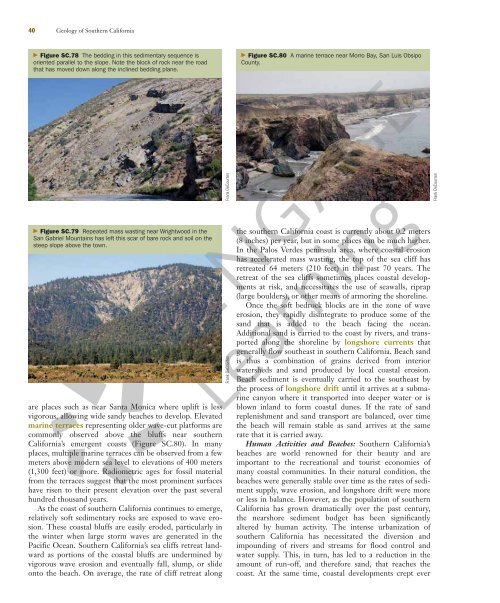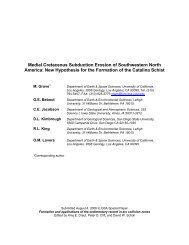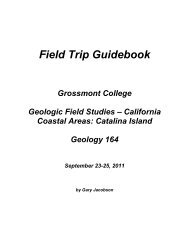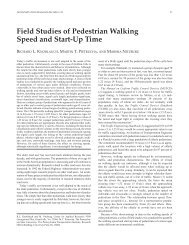Geology of Southern California.pdf - Grossmont College
Geology of Southern California.pdf - Grossmont College
Geology of Southern California.pdf - Grossmont College
Create successful ePaper yourself
Turn your PDF publications into a flip-book with our unique Google optimized e-Paper software.
40 <strong>Geology</strong> <strong>of</strong> <strong>Southern</strong> <strong>California</strong><br />
� Figure SC.78 The bedding in this sedimentary sequence is<br />
oriented parallel to the slope. Note the block <strong>of</strong> rock near the road<br />
that has moved down along the inclined bedding plane.<br />
� Figure SC.79 Repeated mass wasting near Wrightwood in the<br />
San Gabriel Mountains has left this scar <strong>of</strong> bare rock and soil on the<br />
steep slope above the town.<br />
are places such as near Santa Monica where uplift is less<br />
vigorous, allowing wide sandy beaches to develop. Elevated<br />
marine terraces representing older wave-cut platforms are<br />
commonly observed above the bluffs near southern<br />
<strong>California</strong>’s emergent coasts (Figure SC.80). In many<br />
places, multiple marine terraces can be observed from a few<br />
meters above modern sea level to elevations <strong>of</strong> 400 meters<br />
(1,300 feet) or more. Radiometric ages for fossil material<br />
from the terraces suggest that the most prominent surfaces<br />
have risen to their present elevation over the past several<br />
hundred thousand years.<br />
As the coast <strong>of</strong> southern <strong>California</strong> continues to emerge,<br />
relatively s<strong>of</strong>t sedimentary rocks are exposed to wave erosion.<br />
These coastal bluffs are easily eroded, particularly in<br />
the winter when large storm waves are generated in the<br />
Pacific Ocean. <strong>Southern</strong> <strong>California</strong>’s sea cliffs retreat landward<br />
as portions <strong>of</strong> the coastal bluffs are undermined by<br />
vigorous wave erosion and eventually fall, slump, or slide<br />
onto the beach. On average, the rate <strong>of</strong> cliff retreat along<br />
Frank DeCourten<br />
Frank DeCourten<br />
� Figure SC.80 A marine terrace near Morro Bay, San Luis Obsipo<br />
County.<br />
the southern <strong>California</strong> coast is currently about 0.2 meters<br />
(8 inches) per year, but in some places can be much higher.<br />
In the Palos Verdes peninsula area, where coastal erosion<br />
has accelerated mass wasting, the top <strong>of</strong> the sea cliff has<br />
retreated 64 meters (210 feet) in the past 70 years. The<br />
retreat <strong>of</strong> the sea cliffs sometimes places coastal developments<br />
at risk, and necessitates the use <strong>of</strong> seawalls, riprap<br />
(large boulders), or other means <strong>of</strong> armoring the shoreline.<br />
Once the s<strong>of</strong>t bedrock blocks are in the zone <strong>of</strong> wave<br />
erosion, they rapidly disintegrate to produce some <strong>of</strong> the<br />
sand that is added to the beach facing the ocean.<br />
Additional sand is carried to the coast by rivers, and transported<br />
along the shoreline by longshore currents that<br />
generally flow southeast in southern <strong>California</strong>. Beach sand<br />
is thus a combination <strong>of</strong> grains derived from interior<br />
watersheds and sand produced by local coastal erosion.<br />
Beach sediment is eventually carried to the southeast by<br />
the process <strong>of</strong> longshore drift until it arrives at a submarine<br />
canyon where it transported into deeper water or is<br />
blown inland to form coastal dunes. If the rate <strong>of</strong> sand<br />
replenishment and sand transport are balanced, over time<br />
the beach will remain stable as sand arrives at the same<br />
rate that it is carried away.<br />
Human Activities and Beaches: <strong>Southern</strong> <strong>California</strong>’s<br />
beaches are world renowned for their beauty and are<br />
important to the recreational and tourist economies <strong>of</strong><br />
many coastal communities. In their natural condition, the<br />
beaches were generally stable over time as the rates <strong>of</strong> sediment<br />
supply, wave erosion, and longshore drift were more<br />
or less in balance. However, as the population <strong>of</strong> southern<br />
<strong>California</strong> has grown dramatically over the past century,<br />
the nearshore sediment budget has been significantly<br />
altered by human activity. The intense urbanization <strong>of</strong><br />
southern <strong>California</strong> has necessitated the diversion and<br />
impounding <strong>of</strong> rivers and streams for flood control and<br />
water supply. This, in turn, has led to a reduction in the<br />
amount <strong>of</strong> run-<strong>of</strong>f, and therefore sand, that reaches the<br />
coast. At the same time, coastal developments crept ever<br />
Frank DeCourten
















